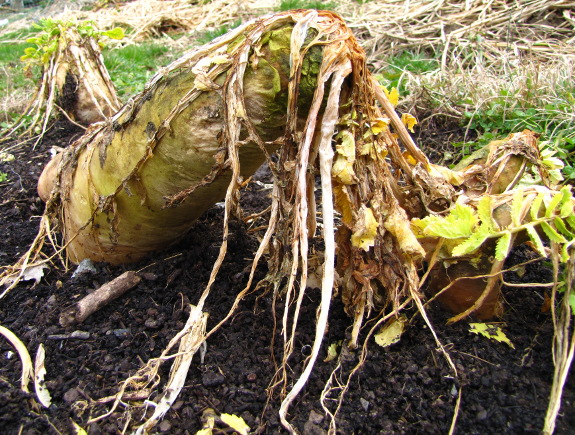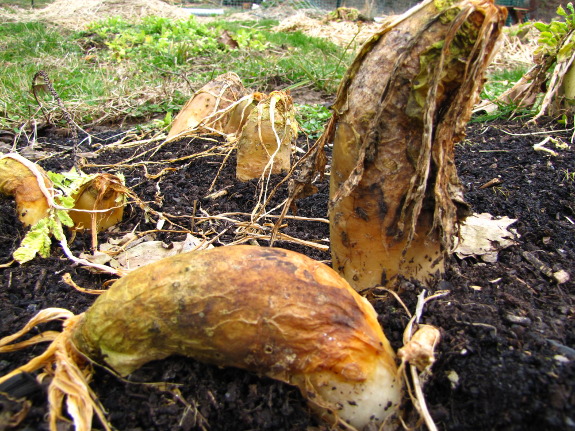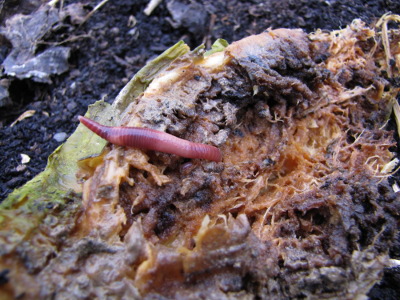
Rotting oilseed radishes

When I first read about oilseed
radishes, the only
negative report claimed that the cover crop stinks to high heaven when
rotting in the spring. I haven't noticed any odor at all from my
decaying oilseed radishes, but their dead bodies do catch the eye with
their striking poses.

 Once
they rot just a bit more than is shown in the two photos above, the
radishes also catch the attention of the local worms. I broke one
radish in half and was surprised to see this earthworm tunneling
through the decaying center.
Once
they rot just a bit more than is shown in the two photos above, the
radishes also catch the attention of the local worms. I broke one
radish in half and was surprised to see this earthworm tunneling
through the decaying center.
Worm action is probably
the reason these huge roots disappear into the soil so quickly.
I'll be able to plant into these beds without raking much of anything
to the side in just a few weeks, and the soil will be improved by up to
a quarter of a pound of dry organic matter per square foot --- not a
bad yield for tossing down a couple of cents' worth of seeds last fall.
Want more in-depth information? Browse through our books.
Or explore more posts by date or by subject.
About us: Anna Hess and Mark Hamilton spent over a decade living self-sufficiently in the mountains of Virginia before moving north to start over from scratch in the foothills of Ohio. They've experimented with permaculture, no-till gardening, trailersteading, home-based microbusinesses and much more, writing about their adventures in both blogs and books.
Want to be notified when new comments are posted on this page? Click on the RSS button after you add a comment to subscribe to the comment feed, or simply check the box beside "email replies to me" while writing your comment.

Great question. My gut says that oats give me more biomass, but "Managing Cover Crops Profitably" (the free cover crop bible) gives the following data on maximum organic matter:
*Oats, fall planted: 2,000 to 4,000 lbs/acre
*Oats, spring planted: up to 8,000 lbs/acre
*Oilseed radishes: up to 8,000 lbs/acre aboveground and up to 3,700 lbs/acre belowground
Of course, those are maximums, so it's quite possible that oats are living up to their full potential here because they like my soil and oilseed radishes are coming in far below their potential. It's hard to say.
I didn't actually notice any stinking at all.
I don't think it's really worth moving cover crops around, unless you grow a huge winter garden and want to be able to treat it with biomass from cover crops. I like to just slip cover crops into dormant windows in my garden.
One thing you especially might like to consider is that many cover crops combine well with pasture systems.
Makes sense. I suppose I was thinking more along the lines of creating biomass for new beds. As in, trying to figure out if there's a way to create a "biomass garden", the finished contents of which could be moved into more strategically placed beds (sun, proximity, etc) instead of using compost, leaf mulch, and other amendments that must be trucked in off site (i.e., starting from scratch). I'm probably trying to make more work out of something than necessary though!
~ Mitsy
I can see where you're coming from, and I do read about people who cut cover crops to add to the compost pile. But it's just so easy to grow them in place...
I think if I was going to grow something to cut and move elsewhere for biomass, I'd grow a grain, thresh the seeds for chicken feed, and use the straw either on the garden beds or as deep bedding in the coop (which would later go in the garden.)
Have you decided to go with an oat cover crop this spring, in the beds you will plant warmer season crops? You've said you mow it then use it as mulch. Does this work well with direct seeding and transplants? I've not used any cover crops and want to start, but I'm worried that a spring plantings roots will leave the soil too hard to work...
Have you done a series or Weekend Homesteader on cover crops?
David --- Great question! After least year, I decided spring cover crops weren't worth it. Oh, they grow like crazy, but they don't die. So, unless you're willing to till them in or rip them up by hand, I'd wait until you can sow some buckwheat for the summer, and then oats and oilseed radishes for the fall.
I felt like cover crops were too advanced for Weekend Homesteader, but you can download the free Managing Cover Crops Profitably at http://www.sare.org/Learning-Center/Books/Managing-Cover-Crops-Profitably-3rd-Edition.